You stare at the computer screen.
Your mind is a blank.
You know you have only 3 seconds.
Then they’re gone. Forever.
Everything hangs on the Intro.
But knowing that just adds to the pressure.
Now you’re paralyzed.
Does this sound familiar?
If so, keep reading.
Because I’m going to show you exactly how to write blog post Intros that suck your readers in like a Dyson vacuum cleaner.
Contents
How Does an Intro Work?
A good intro is like a piece of magic – you feel utterly transfixed by it.
But you could watch that magic trick a hundred times and still not understand how it’s done.
To understand it and do it yourself, you need to go behind the scenes.
And it’s the same with a good Intro.
To understand how it’s done so that you can do it as well, you need to go beneath the surface.
And that’s what I did.
I sat down and analyzed the Intros of over 50 successful blog posts by well-known writers, including such masters of the compelling Intro as John Morrow, Brian Dean, Sonia Simone, and Derek Halpern.
I wanted to understand exactly how they do it.
This is what I discovered: most compelling Intros use one or other of the following two techniques.
Technique #1: The Pain and the Pleasure
- The Hook
- The Problem
- The Solution
- The Promise
This technique aims to trigger an emotional response, the fear of something and the promise of something else.
The Hook
The hook is the opening line of your article. It’s the most important part of your Intro, because you literally have only 3 seconds while your reader decides whether to stay or move on.
That’s why I’ve made it the focus of this article.
But in this technique, the Hook needs to be followed by three other vital elements.
2. The Problem
This is a problem your reader faces.
It’s something they’ve been grappling with and can’t seem to overcome.
It might be getting listed on page #1 of the search results, it might be reducing the weekly spend on groceries, or it might be getting rid of acne.
3. The Solution
This is where you tell them there’s a solution to their problem and you’ve got it.
You don’t have to go into details at this stage but you do have to say that you know how to solve their problem.
4. The Promise
This is the reason they are going to keep reading your post.
It usually looks something like this: “And that’s exactly what I’m going to show you in this article” or “And I’m going to show you exactly how to do that using a simple 3-step strategy”.
Examples
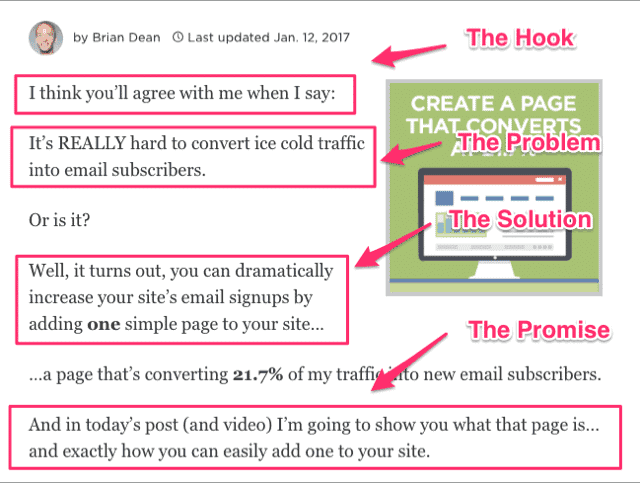

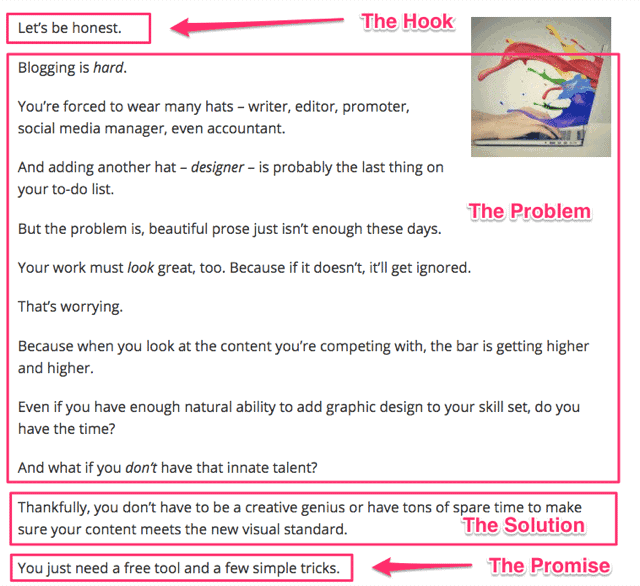
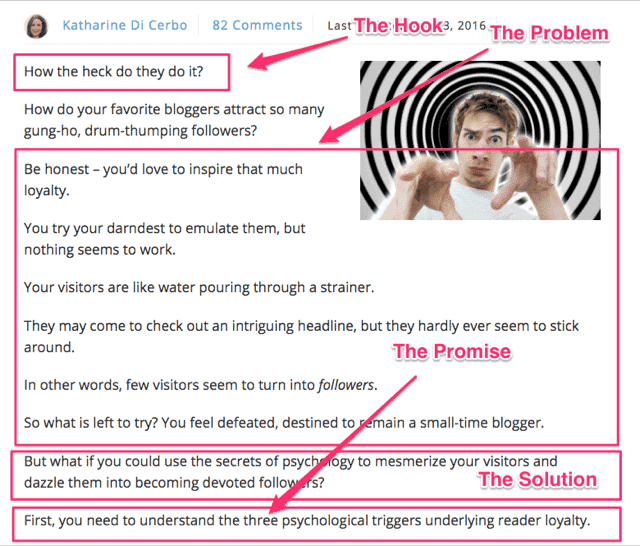
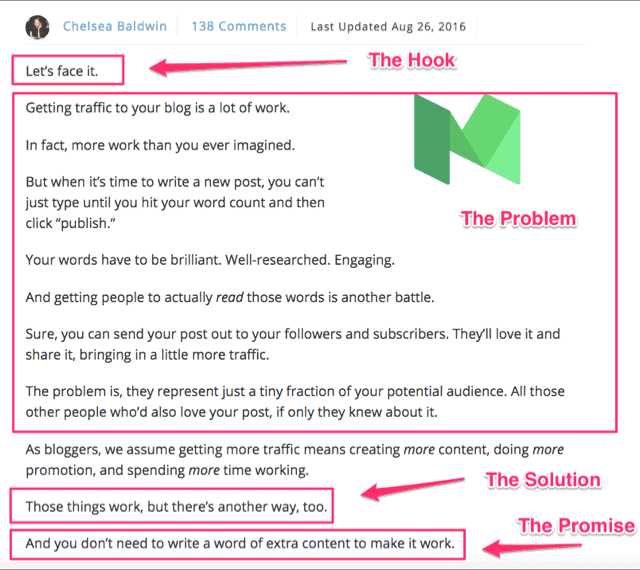
Technique #2: The Simple Transition
- The Hook
- The Transition
- The Thesis
This technique is usually shorter and more straightforward than the previous technique, as you are not trying to hit emotional triggers.
1. The Hook
In this Intro technique, the hook is simply a question that addresses a common need and to which the answer is almost always going to be ‘Yes’.
2. The Transition
The transition connects the hook to the thesis and usually hints at the solution.
In the examples below, the transition states very briefly how the tool mentioned in the hook can benefit the reader
3. The Thesis
The thesis sets out in one sentence what the article will address and why the reader should keep reading.
Examples
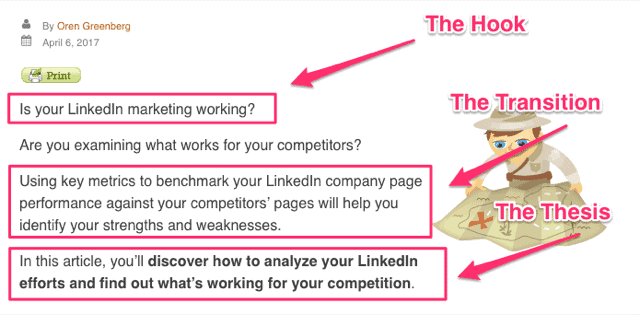
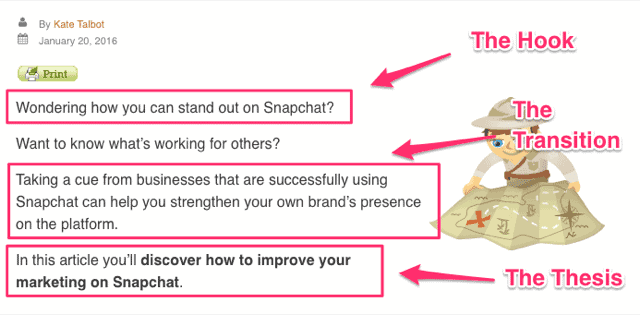
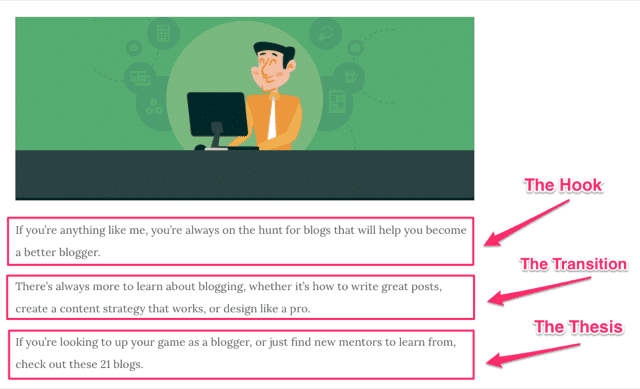
3. Back to the Hook
Now that you’ve understood the structure of a compelling Intro, let’s get back to the hook.
Because, as I said before, it’s the most important part of your blog post.
Ask a question
A question is always an excellent hook because it demands a response.
A question sets up an unfinished dynamic – you can’t leave it without seeing the response.
Examples are:
- Has this happened to you?
You spend hours writing a post, wracking your brains for the best ideas and then crafting your words on the page. And then it falls flat. (Mary Jaksch) - Have you ever wished you could peer inside the mind of one of the greatest writers in the world and find out exactly what makes them tick? (John Morrow)
But there are some questions that don’t require a response.
These are also very effective because they are actually making a statement:
- What is it with interviews? All the top bloggers seem to do them. (Leanne Regalla)
- How the heck do they do it? How do your favorite bloggers attract so many gung-ho, drum-thumping followers? (Katherine Di Cerbo)
- Know what’s tougher than creating great content? Creating it at scale. (Glen Long)
- You know you’re in a war, right? Ok, so no actual guns or tanks are involved, but you are indeed in a bloody battle for the eyes and minds of your readers. (Gary Korsiko)
- Ever notice how some blogs seem to arrive out of nowhere? A few months earlier, you’d never even heard of the blog. (Brian Dean)
Then there are the questions that only have one answer.
These work well when used in the ‘Simple Transition’ technique:
- Want to take your blog to the next level? (Aaron Lee)
- Want to maximize sharing of your content on Facebook? (Dan Zarella)
Make a confession
A confession immediately intrigues us – what terrible thing are they going to admit?
It’s also a very clever way of drawing the reader into your world:
- I’ve got a confession to make: I love reading about business owners who went broke… (Derek Halpern)
- Can I tell you my worst nightmare? (Jon Morrow)
- Blogging has been very good to me over the last twelve and a half years, but it’s come at a personal cost that I’m sure many can relate to. (Darren Rowse)
- Before I became an inbound marketer, I once made $50,000 a month spamming Google. (Jeff Deutsch)
- OK, confession time — when I was a kid I was a… (Sonia Simone)
Get inside your reader’s head
This technique is rather cheeky.
It works very well as a hook because it seems to get right inside the reader’s head:
- Frustrating, isn’t it? You work tirelessly on your content – but no one reads it. (Imran Esmail)
- Let me guess… At least one of your New Year’s resolutions relates to your writing. (Glen Long)
- Annoying as hell, isn’t it? When a guy who launched his first blog a couple of months ago is already getting dozens of comments and hundreds of shares anytime he posts something new. (Will Hoekenga)
- Infuriating, isn’t it? When a site loads so slowly you want to throw your computer out of the window. (Devesh Sharma)
- Admit it. You’ve thought about writing an e-book. In fact, you’ve already imagined the front cover. (Ali Luke)
- Be honest for a moment… When publication day rolls around, do you have a post ready? Or do you frantically scramble at the last minute to figure out what you’re going to write? (Sonia Thompson)
- Don’t try to deny it; you’d love to write a book. In fact, you’ve been dreaming about it so much you can visualize it. (Cathy Presland)
- You want it so bad that it dominates your waking thoughts. You’re even afraid to say it out loud, in case you sound plain crazy: “I want to make a living as a writer.” (Glen Long)
- Strange feeling, isn’t it? Both exciting and terrifying at the same time. But that’s what it’s like, starting an online business. (Blaine Wilkerson)
- Do you feel insecure, anxious and doubtful about your writing? (Jill Jepson)
- A troubling thought, isn’t it? You’re slaving away at your blog, but you can’t help wondering if you have a shot in hell of getting anyone to read it. (Jon Morrow)
Assume something about your reader
This technique is very presumptuous because you’re assuming you know something about the thought processes of your reader.
But it’s also very effective because it creates an immediate bond between you and the reader:
- You know exactly how it happened. (Mary Fernandez)
- No doubt you’ve seen them. The eye-catching posts that promise to reveal the 5, or 10 or even 57 WordPress plugins you absolutely must use on your blog. (Adam Connell)
- You’ve seen it… over, and over, and over again. “The only thing readers read are the headlines.” (Aaron Orendorff)
- You’ve heard it countless time Know your readers. That’s the secret to creating a blog that thrives. (Meera Kothand)
- You’ve heard the advice a million times, right? “To write better, study the writing of other great writers.” (Shane Arthur)
- So you finally decided to take this whole social media thing seriously for your business. (Elna Cain)
- As a marketer, you know the importance of strong search engine rankings. (Adam Connell)
- I think you’ll agree with me when I say: It’s REALLY hard to convert ice-cold traffic into email subscribers. Or is it? (Brian Dean)
Give some bad news
This works well as a hook because we’re all primed to hear bad news (from the doctor, from the boss, from the tax man):
- Blogging is hard. You’re forced to wear many hats – writer, editor, promoter, social media manager, even accountant. (Andy Libunao)
- Getting traffic to your blog is a lot of work. In fact, more work than you ever imagined. (Chelsea Baldwin)
- Can I be painfully honest with you for a moment? (Jon Morrow)
- It hurts me to write this. (Jon Morrow)
Be controversial
This hook sets you apart from the crowd.
It tells the reader that you’re a maverick, a free-thinker, someone with a fresh point of view, or even an expert:
- Some people tell you a story always needs to have a point, but I disagree. Contrary to popular belief, you don’t need to quit your day job to start your own business. (Jon Morrow)
- So many online marketers and web designers will recommend that ‘every business should have a Facebook page’ but I disagree. (Eva Pettifor)
- Contrary to popular belief, Lorem Ipsum is not simply random text. It has roots in a piece of classical Latin literature from 45 BC, making it over 2000 years old. (Unknown)
- Can I be straight up with you? 95% of the advice on the web about how to increase your website traffic is totally useless. (Jon Morrow)
Contrast pain and pleasure
Everyone lives constantly with the prospect of pain and the prospect of pleasure.
Those are the two parameters that guide every decision we make.
So if you put those two things together in your opening sentence, it’s going to grab your reader’s attention:
- Building your personal brand can lead to fame and fortune or it can cost you years of wasted time. (John McDougall)
Use the Title as part of the Intro
This is a very clever hook: the title is a question and the opening sentence is an answer to that question:
- Title: Can I Trust You? The first line of the post: Everyone asks themselves this question. (Seth Godin)
Use Paired Opposites
Binary opposition or paired opposites are fundamental to human thought.
Examples are ‘good/bad’, ‘light/dark’, ‘winner/loser’ etc.
This hook is effective because it taps into a universal thought pattern:
- There are two ways to go about business. The first is to have an idea and then frantically do a lot of stuff hoping some of it works. (Sonia Simone)
Use a statement that doesn’t make sense
Starting your blog post with a sentence that doesn’t make sense on its own almost forces the reader to keep reading:
- It always begins with so much promise. (Sonia Simone)
- Oh, the drama! (Sonia Simone)
Make a shocking statement
In your opening sentence, you really want to stop people in their tracks.
Nothing does that better than a shocking statement (or question):
- I once wrote a newspaper story that killed a man. (Julie Neidlinger)
- We’ve been telling you there’s no great secret to search optimization, but that’s kind of a lie, isn’t it? (Sonia Simone)
- Could it really be possible that almost everything you are doing to promote your website is a waste of time? (Jon Morrow)
State a startling fact
We all love facts.
Maybe because it makes us feel we became a bit smarter in less than a second.
Whatever the reason, opening with a fact will draw your reader in:
- In 1995, authors, experts, and influencers sold $10 million worth of eBooks through Amazon. 18 years later that number has grown to $1.6 billion. (Jeff Bullas)
Start at the end
When your opening sentence hints at the result, it does two things: it tells the reader where this is going and it forces the reader to start wondering how you got there. Very compelling!
- When I started the 8-Week Fitness Challenge, I had no idea what the response might be.
Make a statement your reader will agree with
This works well because when you state something that your reader will agree with, it tells the reader “this is something I need to see”:
- I think you’ll agree with me, it’s a constant struggle to engage your blog readers with new and interesting content. (Martin Nikleva)
- I think you’ll agree with me when I say that building a start-up is hard. (Bill Wilson)
Make a statement that shows you understand your reader
Whenever you open with a statement, or a question, that resonates with your reader, you’ve hooked them because you seem to have a special insight into their problems:
- Raise your hand if you’re a new blogger and you recently signed up for more free webinars than you can count on one hand? (Elna Cain)
- As a blogger, you put your heart and soul into creating perfectly crafted posts, eye-catching images, and attractive leads. It’s a lot of hard work! (Christine C. Renee)
Tell a story
We’re storytelling creatures by nature and have been for tens of thousands of years.
We’re almost hard-wired to hear stories. So this is another powerful hook.
The story-telling hook almost always begins with a reference to a particular moment (as in “Once upon a time”):
- In the early summer of 1976, my life was as any 7-year-old kid’s life should be – fun, making new adventures, and looking forward to a long, glorious school holiday. (Danny Brown)
- About a year and a half ago, I almost moved to a tiny island in the middle of the Chesapeake Bay, Deal Island. (Janessa Lantz).
- On a warm Spring morning in November of 2002, I started my first blog. (Darren Rowse)
Be short and direct
Getting to the point quickly is also a great hook because it doesn’t give the reader time to get think twice:
- Want to maximize sharing of your content on Facebook? Here are seven tips that are sure to help. (Dan Zarella)
- I’ve got three things for you today: A rant, a lesson about selling that will serve you well, and a quick request. (Derek Halpern)
Open with a teaser
Opening with a teaser leaves the reader wondering what it is that you’re going to tell them.
What is this ‘innate human behavior’ that I can take advantage of?
Well, you’ll just have to keep reading:
- How’d you like to learn how to pull your audience into your content by taking advantage of an innate human behavior? (Derek Halpern)
4. Start Writing!
I hope you’ve realized now that writing a compelling Introduction is not that difficult.
Start your post with one of the following hook types:
- Ask a question
- Make a confession
- Get inside your reader’s head
- Assume something about your reader
- Give some bad news
- Be controversial
- Contrast pain and pleasure
- Use the Title as part of the Intro
- Use Paired Opposites
- Use a statement that doesn’t make sense
- Make a shocking statement
- State a startling fact
- Start at the end
- Make a statement that your reader will agree with
- Make a statement that shows you understand your reader
- Tell a story
- Be short and direct
- Open with a teaser
Then pick one of the two Intro techniques described above.
If it’s the Pain/Pleasure technique, describe the painful problem in clear, tangible, and excruciating detail.
Then hint at the solution and make the promise.
If it’s the Simple Transition, open with a “Would you like to know how to…” question. Make the transition.
Then state the thesis: “This article will show you how to…”.
A word of caution.
A powerful Intro will keep people reading your article.
But the body of your article must deliver on the promise or the thesis of the Intro. If it doesn’t, the reader will feel deceived.
One final tip: write the body of the article first and the Introduction last.
The reason?
Before you make the promise in the Intro you need to know what it is you are going to deliver.
Let me know how you go in the comments below.
I’d love to hear your experiences with blog post intros.




